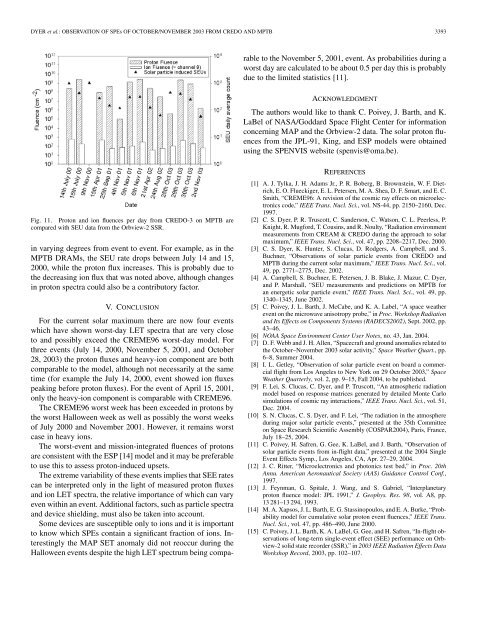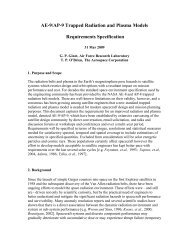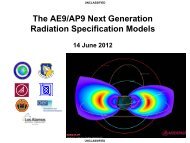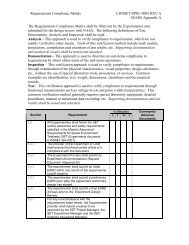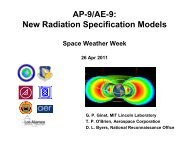Observation of the Solar Particle Events of October ... - IEEE Xplore
Observation of the Solar Particle Events of October ... - IEEE Xplore
Observation of the Solar Particle Events of October ... - IEEE Xplore
You also want an ePaper? Increase the reach of your titles
YUMPU automatically turns print PDFs into web optimized ePapers that Google loves.
DYER et al.: OBSERVATION OF SPEs OF OCTOBER/NOVEMBER 2003 FROM CREDO AND MPTB 3393<br />
V. CONCLUSION<br />
For <strong>the</strong> current solar maximum <strong>the</strong>re are now four events<br />
which have shown worst-day LET spectra that are very close<br />
to and possibly exceed <strong>the</strong> CREME96 worst-day model. For<br />
three events (July 14, 2000, November 5, 2001, and <strong>October</strong><br />
28, 2003) <strong>the</strong> proton fluxes and heavy-ion component are both<br />
comparable to <strong>the</strong> model, although not necessarily at <strong>the</strong> same<br />
time (for example <strong>the</strong> July 14, 2000, event showed ion fluxes<br />
peaking before proton fluxes). For <strong>the</strong> event <strong>of</strong> April 15, 2001,<br />
only <strong>the</strong> heavy-ion component is comparable with CREME96.<br />
The CREME96 worst week has been exceeded in protons by<br />
<strong>the</strong> worst Halloween week as well as possibly <strong>the</strong> worst weeks<br />
<strong>of</strong> July 2000 and November 2001. However, it remains worst<br />
case in heavy ions.<br />
The worst-event and mission-integrated fluences <strong>of</strong> protons<br />
are consistent with <strong>the</strong> ESP [14] model and it may be preferable<br />
to use this to assess proton-induced upsets.<br />
The extreme variability <strong>of</strong> <strong>the</strong>se events implies that SEE rates<br />
can be interpreted only in <strong>the</strong> light <strong>of</strong> measured proton fluxes<br />
and ion LET spectra, <strong>the</strong> relative importance <strong>of</strong> which can vary<br />
even within an event. Additional factors, such as particle spectra<br />
and device shielding, must also be taken into account.<br />
Some devices are susceptible only to ions and it is important<br />
to know which SPEs contain a significant fraction <strong>of</strong> ions. Interestingly<br />
<strong>the</strong> MAP SET anomaly did not reoccur during <strong>the</strong><br />
Halloween events despite <strong>the</strong> high LET spectrum being comparable<br />
to <strong>the</strong> November 5, 2001, event. As probabilities during a<br />
worst day are calculated to be about 0.5 per day this is probably<br />
due to <strong>the</strong> limited statistics [11].<br />
ACKNOWLEDGMENT<br />
The authors would like to thank C. Poivey, J. Barth, and K.<br />
LaBel <strong>of</strong> NASA/Goddard Space Flight Center for information<br />
concerning MAP and <strong>the</strong> Orbview-2 data. The solar proton fluences<br />
from <strong>the</strong> JPL-91, King, and ESP models were obtained<br />
using <strong>the</strong> SPENVIS website (spenvis@oma.be).<br />
Fig. 11. Proton and ion fluences per day from CREDO-3 on MPTB are<br />
compared with SEU data from <strong>the</strong> Orbview-2 SSR.<br />
in varying degrees from event to event. For example, as in <strong>the</strong><br />
MPTB DRAMs, <strong>the</strong> SEU rate drops between July 14 and 15,<br />
2000, while <strong>the</strong> proton flux increases. This is probably due to<br />
<strong>the</strong> decreasing ion flux that was noted above, although changes<br />
in proton spectra could also be a contributory factor.<br />
REFERENCES<br />
[1] A. J. Tylka, J. H. Adams Jr., P. R. Boberg, B. Brownstein, W. F. Dietrich,<br />
E. O. Flueckiger, E. L. Petersen, M. A. Shea, D. F. Smart, and E. C.<br />
Smith, “CREME96: A revision <strong>of</strong> <strong>the</strong> cosmic ray effects on microelectronics<br />
code,” <strong>IEEE</strong> Trans. Nucl. Sci., vol. NS-44, pp. 2150–2160, Dec.<br />
1997.<br />
[2] C. S. Dyer, P. R. Truscott, C. Sanderson, C. Watson, C. L. Peerless, P.<br />
Knight, R. Mugford, T. Cousins, and R. Noulty, “Radiation environment<br />
measurements from CREAM & CREDO during <strong>the</strong> approach to solar<br />
maximum,” <strong>IEEE</strong> Trans. Nucl. Sci., vol. 47, pp. 2208–2217, Dec. 2000.<br />
[3] C. S. Dyer, K. Hunter, S. Clucas, D. Rodgers, A. Campbell, and S.<br />
Buchner, “<strong>Observation</strong>s <strong>of</strong> solar particle events from CREDO and<br />
MPTB during <strong>the</strong> current solar maximum,” <strong>IEEE</strong> Trans. Nucl. Sci., vol.<br />
49, pp. 2771–2775, Dec. 2002.<br />
[4] A. Campbell, S. Buchner, E. Petersen, J. B. Blake, J. Mazur, C. Dyer,<br />
and P. Marshall, “SEU measurements and predictions on MPTB for<br />
an energetic solar particle event,” <strong>IEEE</strong> Trans. Nucl. Sci., vol. 49, pp.<br />
1340–1345, June 2002.<br />
[5] C. Poivey, J. L. Barth, J. McCabe, and K. A. Label, “A space wea<strong>the</strong>r<br />
event on <strong>the</strong> microwave anisotropy probe,” in Proc. Workshop Radiation<br />
and Its Effects on Components Systems (RADECS2002), Sept. 2002, pp.<br />
43–46.<br />
[6] NOAA Space Environment Center User Notes, no. 43, Jan. 2004.<br />
[7] D. F. Webb and J. H. Allen, “Spacecraft and ground anomalies related to<br />
<strong>the</strong> <strong>October</strong>–November 2003 solar activity,” Space Wea<strong>the</strong>r Quart., pp.<br />
6–8, Summer 2004.<br />
[8] I. L. Getley, “<strong>Observation</strong> <strong>of</strong> solar particle event on board a commercial<br />
flight from Los Angeles to New York on 29 <strong>October</strong> 2003,” Space<br />
Wea<strong>the</strong>r Quarterly, vol. 2, pp. 9–15, Fall 2004, to be published.<br />
[9] F. Lei, S. Clucas, C. Dyer, and P. Truscott, “An atmospheric radiation<br />
model based on response matrices generated by detailed Monte Carlo<br />
simulations <strong>of</strong> cosmic ray interactions,” <strong>IEEE</strong> Trans. Nucl. Sci., vol. 51,<br />
Dec. 2004.<br />
[10] S. N. Clucas, C. S. Dyer, and F. Lei, “The radiation in <strong>the</strong> atmosphere<br />
during major solar particle events,” presented at <strong>the</strong> 35th Committee<br />
on Space Research Scientific Assembly (COSPAR2004), Paris, France,<br />
July 18–25, 2004.<br />
[11] C. Poivey, H. Safren, G. Gee, K. LaBel, and J. Barth, “<strong>Observation</strong> <strong>of</strong><br />
solar particle events from in-flight data,” presented at <strong>the</strong> 2004 Single<br />
Event Effects Symp., Los Angeles, CA, Apr. 27–29, 2004.<br />
[12] J. C. Ritter, “Microelectronics and photonics test bed,” in Proc. 20th<br />
Annu. American Aeronautical Society (AAS) Guidance Control Conf.,<br />
1997.<br />
[13] J. Feynman, G. Spitale, J. Wang, and S. Gabriel, “Interplanetary<br />
proton fluence model: JPL 1991,” J. Geophys. Res. 98, vol. A8, pp.<br />
13 281–13 294, 1993.<br />
[14] M. A. Xapsos, J. L. Barth, E. G. Stassinopoulos, and E. A. Burke, “Probability<br />
model for cumulative solar proton event fluences,” <strong>IEEE</strong> Trans.<br />
Nucl. Sci., vol. 47, pp. 486–490, June 2000.<br />
[15] C. Poivey, J. L. Barth, K. A. LaBel, G. Gee, and H. Safren, “In-flight observations<br />
<strong>of</strong> long-term single-event effect (SEE) performance on Orbview-2<br />
solid state recorder (SSR),” in 2003 <strong>IEEE</strong> Radiation Effects Data<br />
Workshop Record, 2003, pp. 102–107.


